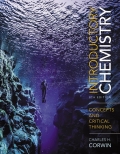
(a)
Interpretation:
The labeling of each atom in the polar covalent bond
Concept introduction:
Electronegativity is defined as the tendency of an atom to attract electrons towards it. Polarized bonds are a result of the electronegativity difference between bonding atoms. The more electronegative atom acquires a partial negative charge and the less electronegative atom acquires partial positive charge while showing charge distribution.
Answer to Problem 53E
The polar
Explanation of Solution
The electronegativity of an element increases along the period from left to right and decreases down in the group. From the figure
The polar
(b)
Interpretation:
The labeling of each atom in the polar covalent bond
Concept introduction:
Electronegativity is defined as the tendency of an atom to attract electrons towards it. Polarized bonds are a result of the electronegativity difference between bonding atoms. The more electronegative atom acquires a partial negative charge and the less electronegative atom acquires partial positive charge while showing charge distribution.
Answer to Problem 53E
The polar
Explanation of Solution
The electronegativity of an element increases along the period from left to right and decreases down in the group. From the figure
The polar
(c)
Interpretation:
The labeling of each atom in the polar covalent bond
Concept introduction:
Electronegativity is defined as the tendency of an atom to attract electrons towards it. Polarized bonds are a result of the electronegativity difference between bonding atoms. The more electronegative atom acquires a partial negative charge and the less electronegative atom acquires partial positive charge while showing charge distribution.
Answer to Problem 53E
The polar
Explanation of Solution
The electronegativity of an element increases along the period from left to right and decreases down in the group. From the figure
The polar
(d)
Interpretation:
The labeling of each atom in the polar covalent bond
Concept introduction:
Electronegativity is defined as the tendency of an atom to attract electrons towards it. Polarized bonds are a result of the electronegativity difference between bonding atoms. The more electronegative atom acquires a partial negative charge and the less electronegative atom acquires partial positive charge while showing charge distribution.
Answer to Problem 53E
The polar
Explanation of Solution
The electronegativity of an element increases along the period from left to right and decreases down in the group. From the figure
The polar
Want to see more full solutions like this?
Chapter 12 Solutions
EBK INTRODUCTORY CHEMISTRY
- 14. Calculate the concentrations of Ag+, Ag(S2O3), and Ag(S2O3)23- in a solution prepared by mixing 150.0 mL of 1.00×10-3 M AgNO3 with 200.0 mL of 5.00 M Na2S2O3 Ag+ + S20 Ag(S203)¯ K₁ = 7.4 × 108 Ag(S203)¯ + S20¯ = Ag(S203) K₂ = 3.9 x 104arrow_forwardΗΝ, cyclohexanone pH 4-5 Draw Enamine I I CH3CH2Br THF, reflux H3O+ I Drawing Draw Iminium Ionarrow_forward:0: :0: Select to Add Arrows :0: (CH3)2NH :0: ■ Select to Add Arrows :0: :0: (CH3)2NH ■ Select to Add Arrowsarrow_forward
- Draw the product of the following H action sequence. Ignore any inorganic byproducts formed. 1. (CH3CH2)2CuLi, THF 2. CH3Br Q Atoms, Bonds and Rings H Charges ㅁarrow_forwardPlease help me with this the problem is so confusingarrow_forward14 Question (1 point) Disiamylborane adds to a triple bond to give an alkenylborane. Upon oxidation with OH, H2O2, the alkenylborane will form an enol that tautomerizes to an aldehyde. In the first box below, draw the mechanism arrows for the reaction of disiamylborane with the alkyne, and in the last box draw the structure of the aldehyde. 4th attempt Feedback i > 3rd attempt OH, H2O2 i See Periodic Table See Hintarrow_forward
- answer with mechanisms and steps. handwritten please!arrow_forwardHello I need some help with Smartwork. For drawing structure B, I know the correct answer is CH₃B₂, but when I try to type it in, it keeps giving me CH₄BH₃ instead. Do you know how I should write it properly? Should I use a bond or something else?arrow_forwardTrue or false, chemistryarrow_forward
- answer thse questions with mechanisms and steps. handwritten please!arrow_forwardC app.aktiv.com Draw the product of the following reaction sequence. Ignore any inorganic byproducts formed. H O 1. (CH3CH2)2CuLi, THF 2. CH3Br Drawingarrow_forwardDraw the product of the following reaction sequence. Ignore any inorganic byproducts formed. H O 1. (CH3CH2)2CuLi, THF 2. CHзBr Drawingarrow_forward
 Introduction to General, Organic and BiochemistryChemistryISBN:9781285869759Author:Frederick A. Bettelheim, William H. Brown, Mary K. Campbell, Shawn O. Farrell, Omar TorresPublisher:Cengage Learning
Introduction to General, Organic and BiochemistryChemistryISBN:9781285869759Author:Frederick A. Bettelheim, William H. Brown, Mary K. Campbell, Shawn O. Farrell, Omar TorresPublisher:Cengage Learning
 ChemistryChemistryISBN:9781305957404Author:Steven S. Zumdahl, Susan A. Zumdahl, Donald J. DeCostePublisher:Cengage Learning
ChemistryChemistryISBN:9781305957404Author:Steven S. Zumdahl, Susan A. Zumdahl, Donald J. DeCostePublisher:Cengage Learning Chemistry: An Atoms First ApproachChemistryISBN:9781305079243Author:Steven S. Zumdahl, Susan A. ZumdahlPublisher:Cengage Learning
Chemistry: An Atoms First ApproachChemistryISBN:9781305079243Author:Steven S. Zumdahl, Susan A. ZumdahlPublisher:Cengage Learning



